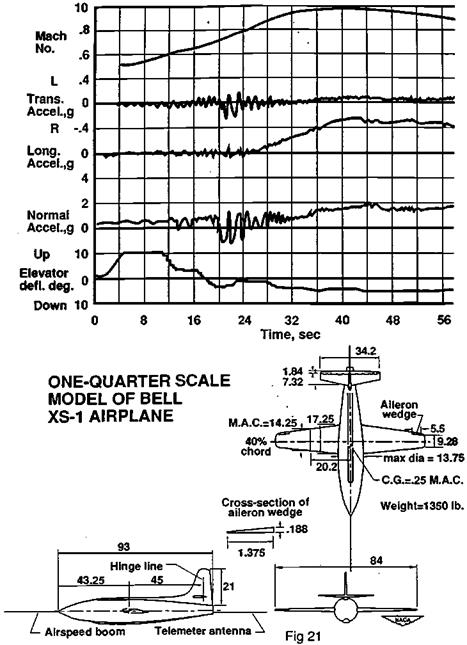The Phillips Inertial Coupling Technical Note
Electronic digital computerswere still yearsaway when Phillipsdid hisinertial coupling research. For numerical solutions that would attack the problem Phillips was obliged to simplify the equations with a series of ingenious mathematical steps. His successive transformations led to inertial coupling stability boundaries derived by a simple quadratic equation.
For generality, Phillips nondimensionalized aircraft static stability parameters in terms of rolling frequency, or number of complete roll cycles per second. That is, the levels of both longitudinal and directional static stability or stiffness are characterized by their respective nonrolling natural frequencies, in short-period longitudinal and Dutch roll modes. These frequencies, expressed as cycles per second, are divided by the rolling frequency, as defined above, for the Phillips charts (Figure 8.2).
The remarkable but strong mathematical transformations added to the academic flavor of the charted results obscured the work’s significance to the hard-pressed stability and control engineers working in aircraft plants in the late 1940s, who should have paid more attention to Phillips’ results. Had a 1980s type digital computer been available to Phillips in 1947, permitting a few time histories of forthcoming fighter aircraft full-aileron rolls to
|
Figure 8.1 The smoking gun – The XS-1 flight record that gave evidence of rapid oscillations in normal and lateral accelerations during steady rolling. The XS-1 drop model had an aileron wedge designed to make it roll steadily. (From Phillips, Jour. of theAmer. Aviation Historical Soc., Summer 1992) |
|
Figure 8.2 An example of the W. H. Phillips inertial coupling stability boundaries. (From Phillips, NACATD 1627, 1948) |
be calculated and presented, the airplane stability and control community would have taken notice.
Interesting background on Phillips’ inertial coupling work was contained in a 1994 letter from him. An excerpt from the letter reads:
In thinking about the subject lately, I have concluded that my approach was based on my training at MIT. In the courses that I took, particularly by Prof. Koppen, the derivations did not start with the complete equations of motion. The equations had already been divided into lateral and longitudinal groups and linearized. In Prof. Draper’s courses on instrumentation, much emphasis was placed on nondimensionalizing the results in terms of natural frequency. I did not read Bryan’s report, which starts from basic principles, for many years after that. If I had known the complete equations of motion, I might have been discouraged from attempting a solution.
While W. H. Phillips gave the first account of inertial coupling in the open literature, there seems to have been at least three other independent discoveries of inertial coupling. While working at the Boeing Company on the then-classified Bomarc missile, Roland J. White, Dunstan Graham, D. Murray, and R. C. Uddenberg found the problem and reported it in a Boeing Company document dated February 1948. At the Douglas Company’s El Segundo Division about the same time, Robert W. Bratt found inertial coupling in drop tests of a dummy Mark 7 bomb shape. A small amount of fin twist made the bomb spin. When the spin rate agreed with the bomb’s natural pitch frequency the spin went flat, or broadside to the wind.
Additional early work involving inertial coupling took place at the Cornell Aeronautical Laboratory in Buffalo, New York, by Donald W. Rhoads, John M. Schuler, and J. C. O’Hara. This was sponsored by the Structures Branch of the U. S. Air Force Wright Aircraft Laboratory, starting in 1949. Rhoads, Schuler, and O’Hara studied rolling pullouts, maneuvers that combine rolls and pullups. During the latter part of World War II vertical tail failures had occurred during rolling pullouts, as a result of large side-slip angles (Rhoads and Schuler, 1957).
Rhoads, Schuler, and O’Hara included inertial coupling terms in their study, among other refinements. Calculations of the critical peak side-slip angles agreed well with flight tests. However, their early numerical work, done at about the same time as the Phillips discovery, was for the Lockheed P-80 Shooting Star, whose inertial parameters are not much different than those of World War II airplanes. The P-80 has straight wings of moderately high aspect ratio and a fairly small value of the important inertial coupling parameter (Ix — Iy )/Iz. Inertial coupling was not prominent in the early stages of the Cornell Laboratory rolling pullout work, which actually extended over a period of five years. The stability and control community was not alerted.
The Phillips inertial coupling work, followed by flight occurrences of the phenomenon, led to a series of studies in Great Britain. W. J. G. Pinsker (1955, 1957, 1958) and H. H. B. M. Thomas (1960) were especially active.
Thus, the inertial coupling phenomenon, having been discovered in the late 1940s, was ignored by airplane designers until it was rediscovered in flight in the early 1950s. By 1956, the U. S. industry was roused enough to turn out for a conference on the subject held at Wright Field.













